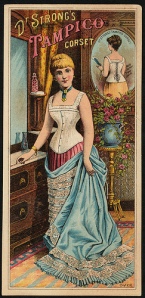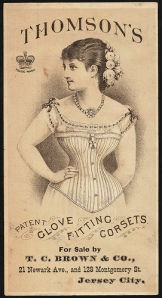I was doing some research on famous women in history when something occurred to me. Now the women I have researched have overcome tremendous odds. They have battled discrimination, unbelievable hardships and oppression to carve their very conspicuous paths through history. Their biggest obstacle, though, may have been something we rarely ever think of, their skivvies.
What occurred to me, and what modern women today may not think about, is how fashion, historically, has kept women, in kind of, well, bondage. Today we wouldn’t even consider doing housework, or field work, in a dress but, until the 1900s, dresses were what women wore, all the time. I checked out the dresses of the 1700s, 1800s, and early 1900s. Good grief! Women wore layers and layers of material, long puffy sleeves, big impossible hats, gloves, stockings, summer and winter. I get a heat rash just thinking about it.
Then, when I did a little more digging, I found that what was underneath those voluminous layers of clothes was even more horrendous. First of all, women didn’t really do, uh, what we think of as briefs, until the 1940s. In the early days, women wore nothing to cover up their southern nether region. That’s right, nothing. Lady bits were left to just, air out, I guess. Seriously, this is one reason why nothing down there was covered. They thought it was healthier. Kinda shocking, huh.
I know what you’re thinking. I thought about it too. What did they do about their monthly cycle? Well, it turns out they did nothing. Leaked right into their clothes. Yep. Oh there were other ways to deal with it too. For good information on this particular problem go to: http://www.mum.org/index.html. Moving on…
What was covered was squeezed, pushed and plumped. Corsets were considered a must do in the 1600’s and for a couple of centuries afterward. The well-to-do wore corsets made of whalebone. Later even the most poverty stricken wore corsets made of wood or wire. They were laced tight in the back and even children were expected to wear them from a very early age. Poor little guys probably never knew what it felt like to take a good deep breath.
A chemise was worn under the corset. A chemise looked something like a nightgown and everybody wore those too. By the way, the children wore nothing under them either, even babies, no diapers, ugh.
So we have the chemise, the corset, then we have the petticoats. Some were embroidered and fancy, some were plain but the thing about the petticoats was how many a woman was expected to wear. To get the fashionable big skirt look, petticoats had to be layered unde the dress. Sometimes close to twenty would be worn at once. Now this wouldn’t be so bad in the dead of winter. But what about in the summertime, with no air conditioning, not even a fan?
In the 1800s women began to wear knickers or drawers, (they were called drawers because they were drawn on). There was a problem though. Women were still wearing long skirts, corsets, shifts and petticoats. The problem was, you guessed it, the chamber pot. The knickers were popular because they helped keep the legs warm in the winter and because something else had been added to the proper lady’s undergarments, the wire hoop.
The wire hoop immediately became all the rage because it reduced the amount of petticoats needed to get that billowing ample bottom look that was so popular at the time. Yes, today we just do implants, much easier, right? When young ladies bent over the dress went up, think of a bell, and their private lady bits were displayed to any appreciative males that happened to be nearby. So knickers became popular, but there was still the chamber pot issue. Hum… problem, solution…crotchless knickers! And you thought those kinds of undies were sold only at Victoria’s Secret.
In the 1920s dress styles slimmed down and shortened up. Knickers would be called bloomers and start being sewn at the crotch. They would also become shorter, rising to above the knee. Bras would also catch on during this time, (the first one was two handkerchiefs tied together by a ribbon).
By the 1940s nylon stockings became fashionable and women started wearing briefs. Oh the joy of nylon! The petticoats were long gone and morphed into nylon slips. Women still wore girdles and garter belts to hold up their stockings, but compared to the discomfort and pure torture of whalebone corsets, this was no biggy.
In the early 1960s pantyhose became fashionable. Today most women hate the thought of wrestling their bodies into that hot, tight, easily torn bit of shrunken nylon. But, hey, think of our ancestors and, again those whalebone corsets. We don’t have it so bad now, do we?
By the 1990s the thong became popular, and Victoria’s Secret, and crotchless undies. Looks like we’ve gone full circle doesn’t it? Hopefully we won’t end up back in the long skirts and petticoats. I don’t think we’ll have to worry about it. Somehow, I don’t think this generation of women would go for it.
For more information, you might want to check out: http://www.localhistories.org/womenund.html by Tim Lambert
Go to Youtube for a fascinating lecture on the subject given by H. Kristina Haugland from the Indianapolis Museum, titled “Revealing Garments: A Brief History of Womans Underwear.”
Photos courtesy of:
Corset 1:
photo credit: <a href=”https://www.flickr.com/photos/boston_public_library/9670240431/”>Boston Public Library</a> via <a href=”http://photopin.com”>photopin</a> <a href=”http://creativecommons.org/licenses/by/2.0/”>cc</a>
Corset 2:
photo credit: <a href=”https://www.flickr.com/photos/boston_public_library/9670241887/”>Boston Public Library</a> via <a href=”http://photopin.com”>photopin</a> <a href=”http://creativecommons.org/licenses/by/2.0/”>cc</a>
bustle, cage crinoline, corset:
Photograph LACMA
Lucy Stone in Bloomers:
== {{int:filedesc}} == {{Information |Description={{en|A scan of an engraving printed in ”Illustrated News”, May 28, 1853, scanned by Kansas Historical Society, showing Lucy Stone wearing bloomers.}} |Source=[http://www.kshs.org/sesqu




